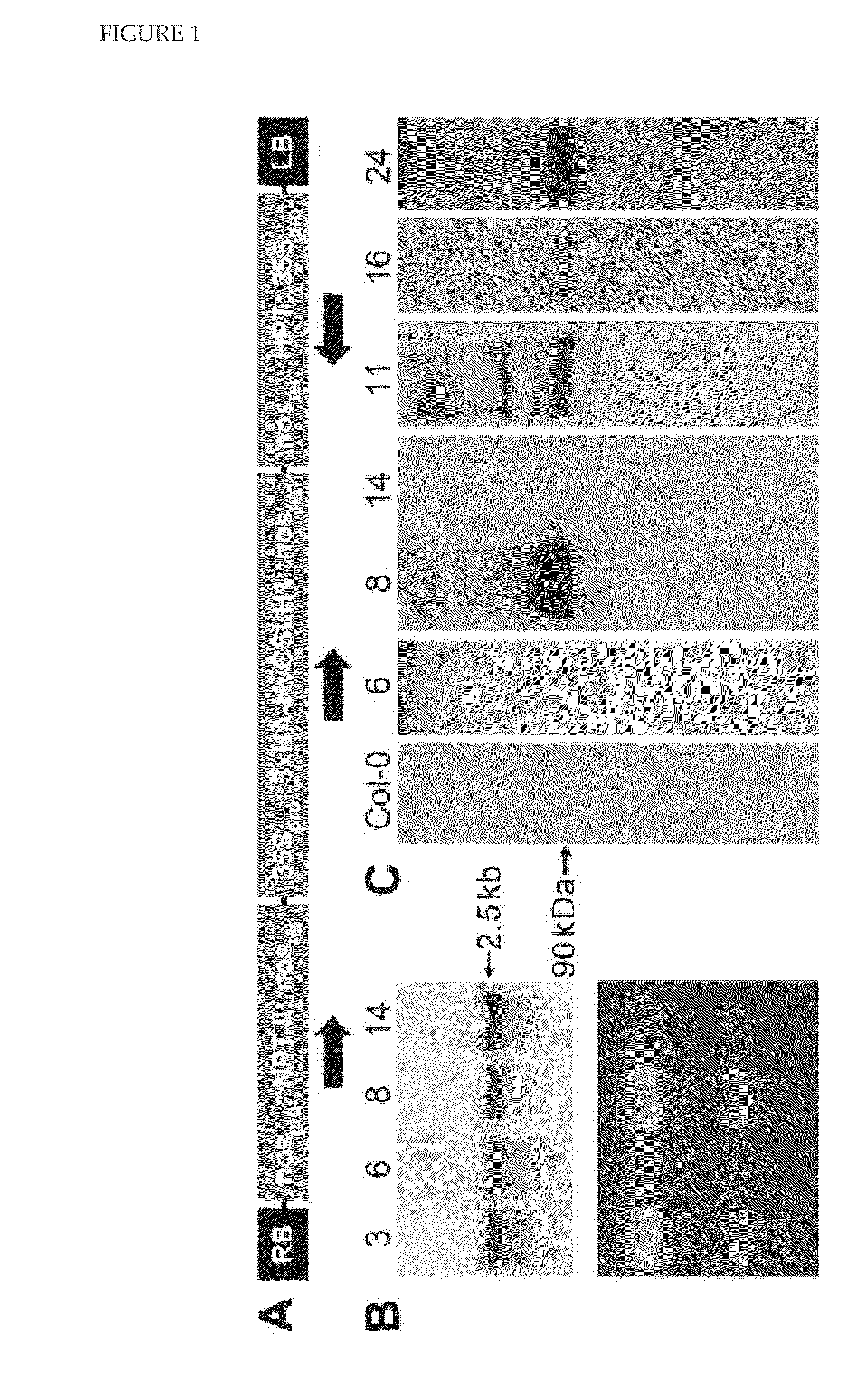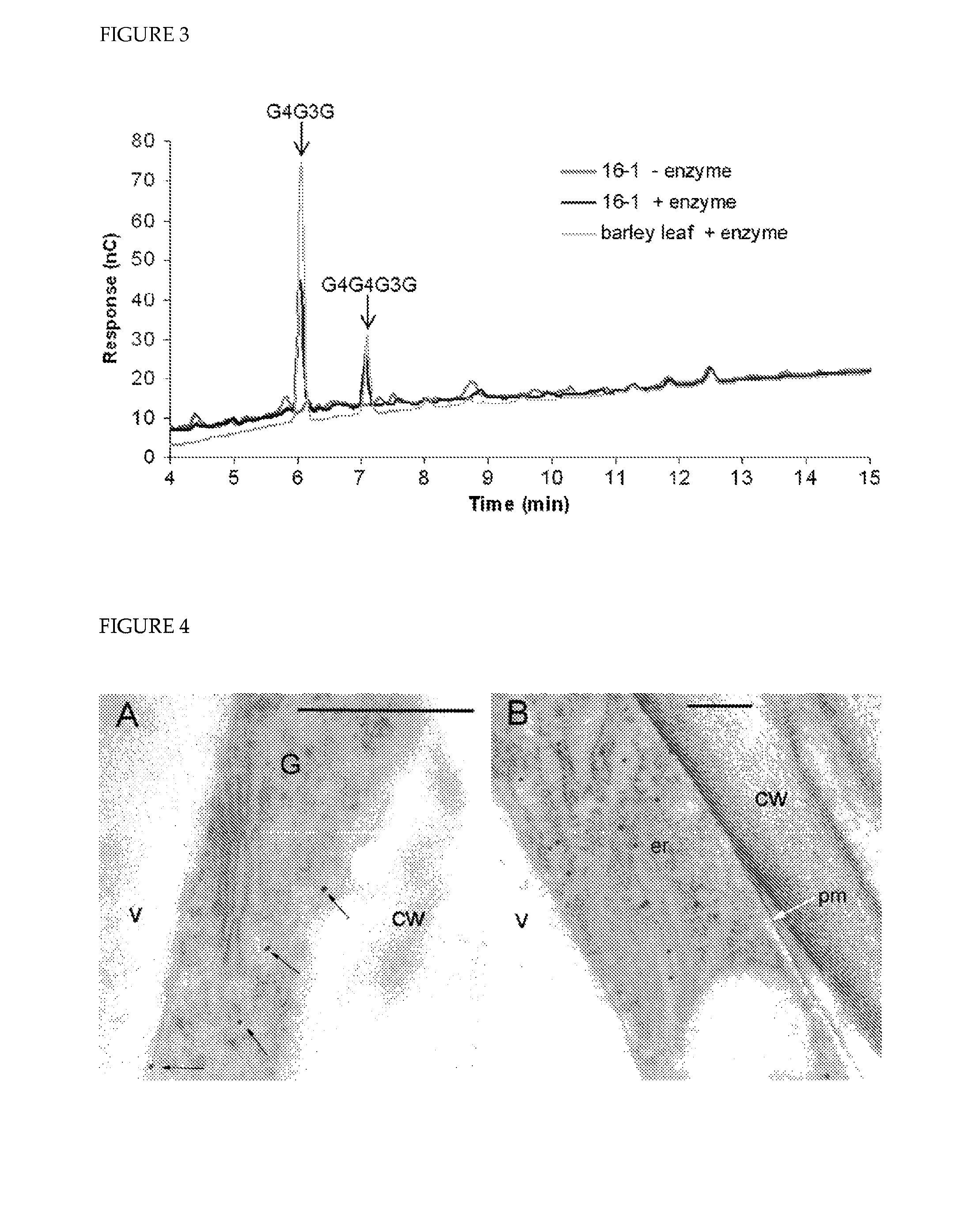Polysaccharide synthases (H)
a polysaccharide and synthesizer technology, applied in the field of polysaccharide syntheses, can solve the problems of major gaps in our knowledge of genes and enzymes, and the death of outer grain tissues, and achieve the effect of facilitating the production of (1,3,1,4)--d-glucan
- Summary
- Abstract
- Description
- Claims
- Application Information
AI Technical Summary
Benefits of technology
Problems solved by technology
Method used
Image
Examples
example 1
Barley has Only One CSLH Gene
[0245]Candidate CSLH genes in barley were initially identified by querying online EST databases, such as the discontinued Stanford cell wall website, NCBI, HarvEST, GrainGenes, Barley Gene Index and BarleyBase, with rice CSLH sequences. All CSLH-related ESTs from barley could be aligned into a single contiguous sequence of ˜1,500 bp that included the entire 3′ untranslated region (UTR) and a region encoding the COOH-terminal 488 (of an expected ˜750) amino acid residues of the protein (Table 2). This gene was designated HvCslH1. Screening of a barley BAC library with HvCslH1-derived probes identified several genomic clones all containing HvCslH1, from which the missing 5′ end was obtained (data not shown). A 2,430 bp HvCslH1 cDNA fragment was PCR-amplified, contains a single 2,256 bp ORF, and encodes a protein with a predicted MW of 82.6 kDa and a pI of 7.0 (FIG. 6A). Analysis of the conceptual translation of this sequence with ARAMEMNON found between fi...
example 2
Expression of HvCslH1 in Arabidopsis Results in Deposition of (1,3;1,4)-β-D-Glucan
[0250]For heterologous expression in Arabidopsis, the HvCslH10RF was cloned into the Gateway-enabled binary vector pGWB15 (Nakagawa et al., J Biosci Bioeng 104: 34-41, 2007; FIG. 15), which placed HvCslH1 under the control of the CaMV 35S promoter and added a 3×HA epitope tag to the encoded protein's NH2-terminal end (FIG. 1A). Initial selection of transformed Arabidopsis seeds identified a number of putative transgenic seedlings which PCR confirmed contained HvCslH1. RNA blot analysis of these T1 plants showed that approximately 90% accumulated HvCslH1 transcripts in rosette leaves (FIG. 1B). Western blotting using an anti-HA tag antibody was used to detect HvCslH1 protein in these lines (FIG. 1C). A mixed microsomal membrane fraction (50,000-100,000×g pellet) was prepared from pooled three-week old kanamycin-resistant T2 seedlings. Western blotting with the anti-HA antibody showed that only four of t...
example 3
[0253]HvCslH1 is Located in ER- and Golgi-Associated Vesicles but not the Plasma Membrane of Transgenic Arabidopsis Plants Expressing HvCslH1
[0254]Sections of high pressure-frozen leaves from line 11 were incubated with the gold-labelled anti-HA antibody to determine the sub-cellular location of HvCslH1. Labelling was seen in the endoplasmic reticulum and in Golgi-derived vesicles but not in the plasma membrane (FIG. 4A, B). Similar results were observed in labelled sections of roots and seedlings (data not shown).
PUM
| Property | Measurement | Unit |
|---|---|---|
| weight average to number average molecular mass ratio | aaaaa | aaaaa |
| temperatures | aaaaa | aaaaa |
| temperatures | aaaaa | aaaaa |
Abstract
Description
Claims
Application Information
 Login to View More
Login to View More - R&D
- Intellectual Property
- Life Sciences
- Materials
- Tech Scout
- Unparalleled Data Quality
- Higher Quality Content
- 60% Fewer Hallucinations
Browse by: Latest US Patents, China's latest patents, Technical Efficacy Thesaurus, Application Domain, Technology Topic, Popular Technical Reports.
© 2025 PatSnap. All rights reserved.Legal|Privacy policy|Modern Slavery Act Transparency Statement|Sitemap|About US| Contact US: help@patsnap.com



